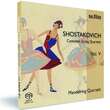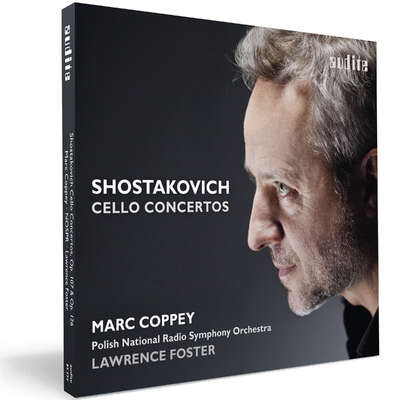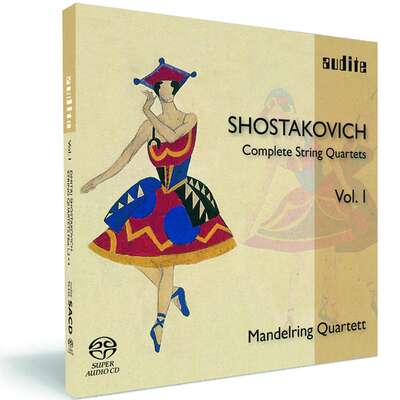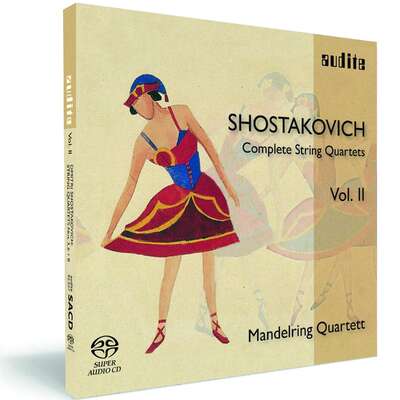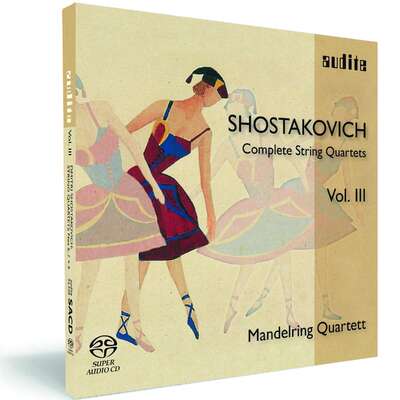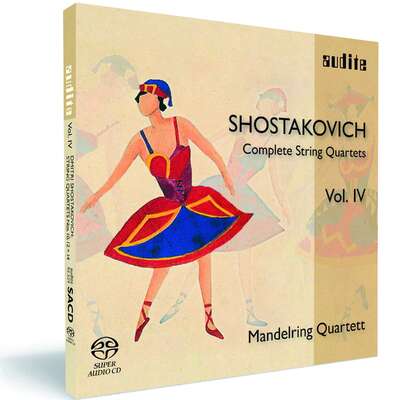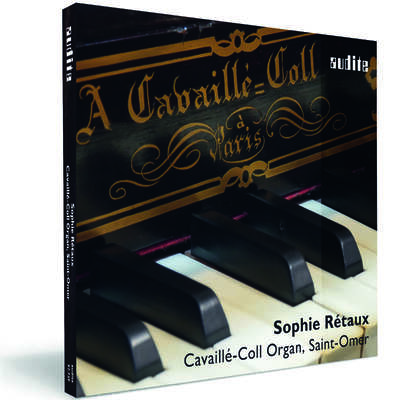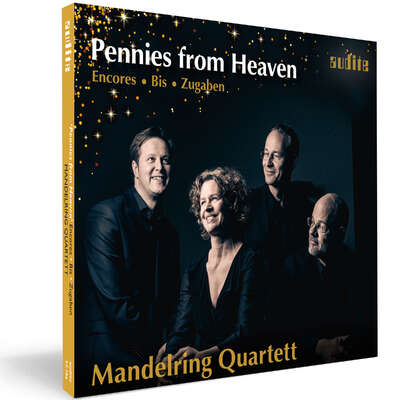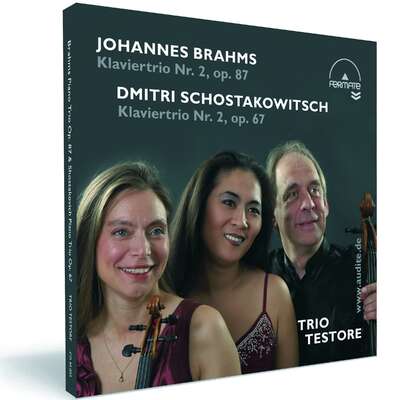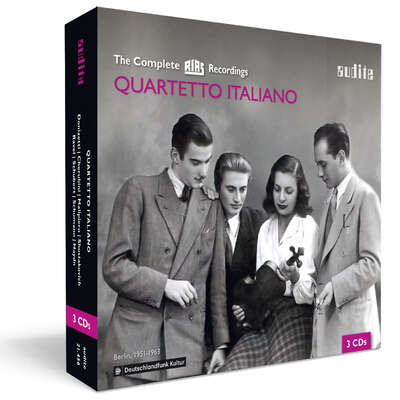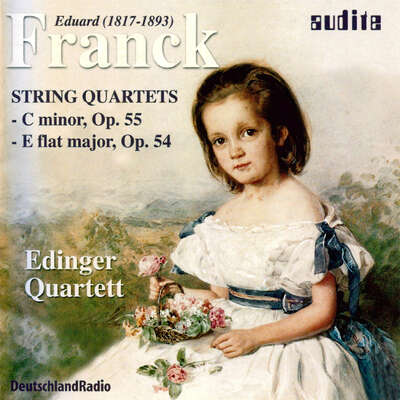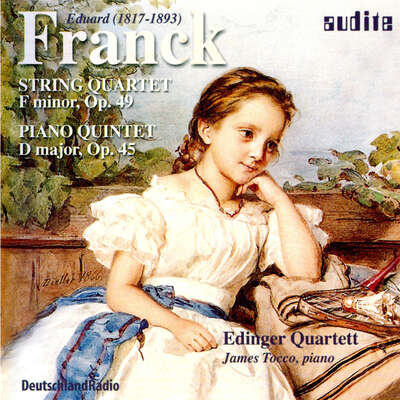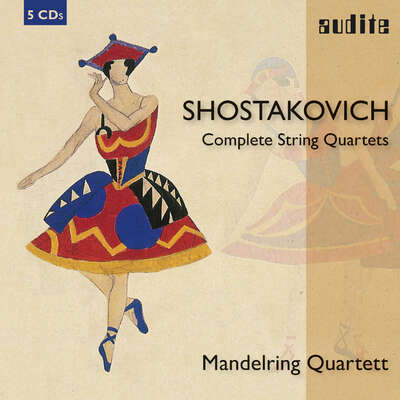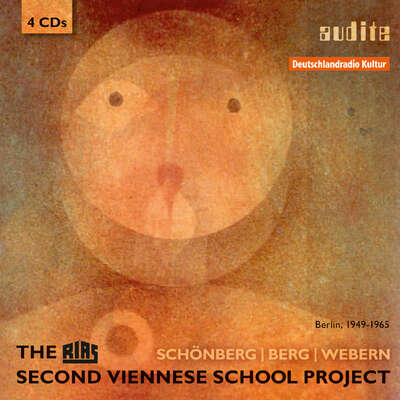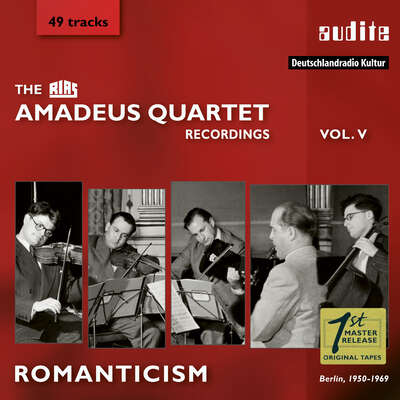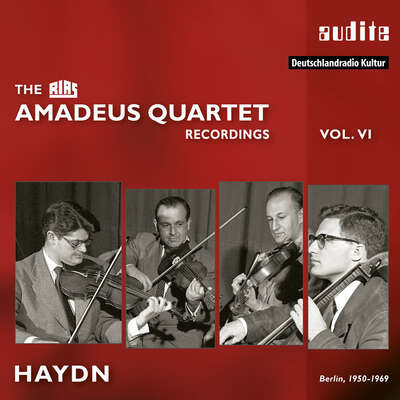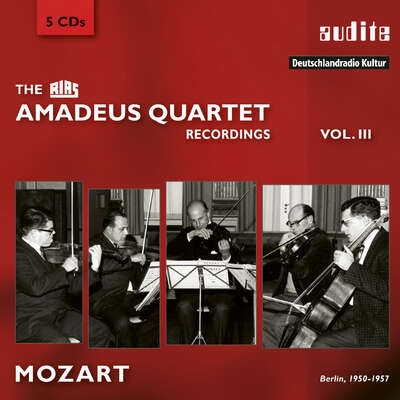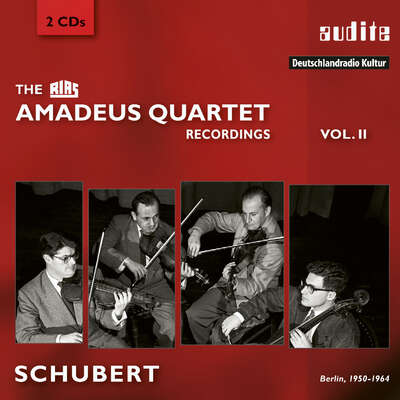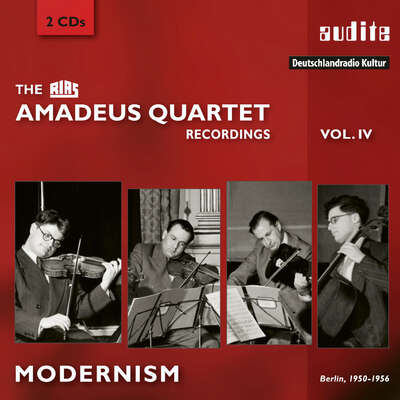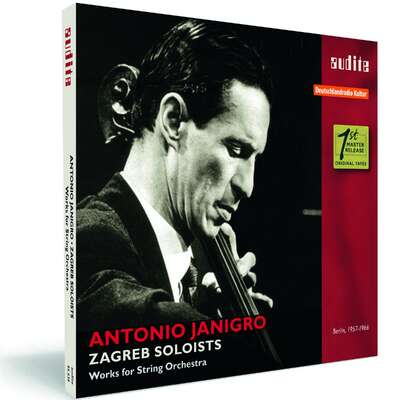
“... to give it a strong vote as the Shostakovich cycle of choice.“ (International Record Review 5/2009) With Vol. V the Mandelring Quartet has accomplished its complete edition of the fifteen string quartets of Dmitri Shostakovich . Highly praised in the trade press as one of the...more
"There's a bleak intensity to these late quartets." (The Independent)
Details
| Dmitri Shostakovich: Complete String Quartets Vol. V | |
| article number: | 92.530 |
|---|---|
| EAN barcode: | 4022143925305 |
| price group: | ACX |
| release date: | 9. October 2009 |
| total time: | 67 min. |
Bonus Material
Informationen
“... to give it a strong vote as the Shostakovich cycle of choice.“
(International Record Review 5/2009)
With Vol. V the Mandelring Quartet has accomplished its complete edition of the fifteen string quartets of Dmitri Shostakovich. Highly praised in the trade press as one of the outstanding complete editions of our time the last volume presents the Quartets Nos. 11, 13 and 15. The musical language of these late chamber works becomes more jagged, the colours more pale and the tone more elegiac.
The Eleventh String Quartet of Dmitri Shostakovich received its premiere in the former Leningrad at the preliminary celebrations of the composer’s sixtieth birthday. During the very same night, the composer suffered a serious heart attack which changed his life and way of thinking. While his daily life was determined by stays in hospital and at health resorts, Shostakovich occupied himself very frequently with death in his late works. And the three works recorded here, too, are either commemorative works written for colleagues or requiem-compositions in view of the composer’s own end.
Quartet No. 11 (1966), dedicated to the late violinist of the Beethoven Quartet, an ensemble with which the composer was intimately acquainted, appears as a multi-movement suite in which character pieces such as the “Etude” and the “Humoresque” turn up – with a grim, cynical humour, of course. The 13th Quartet composed in 1970 is dedicated to the violist of the Beethoven Quartet and is a portrait, in a single monumental movement, of this instrument that Shostakovich loved so much. In the final, 15th Quartet (1974), the composer finally seizes upon a radical formal solution: six Adagio movements come together to form a large work of mourning which bears no more dedication…
With Shostakovich’s fifteen string quartets the Mandelring Quartet presents a quartet cycle, which in its entirety probably represents the most important corpus of string quartets of the twentieth century.
Please find a video with impressions from the recording sessions and interviews with the musicians here.
Reviews
Sunday Telegraph | 9 January 2011 | Michael Kennedy | January 9, 2011 Shostakovich String Quartets
This is the fifth volume of the Shostakovich quartets recorded byMehr lesen
Sikorski | August 2010 | August 1, 2010 Gesamteinspielung der Schostakowitsch-Quartette durch das Mandelring Quartett komplett
Die späten Streichquartette von Dmitri Schostakowitsch fallen in eineMehr lesen
Strings Magazine | June 2010 | Edith Eisler | June 1, 2010
Composers always express themselves most intimately in their string quartets. Dmitri Shostakovich (1906–1975) was no exception, despite theMehr lesen
The Mandelring Quartet’s repertoire is wide and inclusive, but that such vivacious, robust young musicians should want to immerse themselves in this mournful, despondent music is amazing. Equally remarkable is the skill with which they negotiate its violent mood swings, from grotesque “gallows humor” to bleak despair. The solos and duets are spare and desolate, the slashing chords forceful, the sound effects eerie, the long glissandi – very slow, almost measured – ominous. The Mandelrings underline contrasts of mood and character with color and articulation. Despite using sparing vibrato in the usually unvibrated opening movement of String Quartet No. 15, they make it sound bereft of color and life.
Their playing is expressive, but avoids excess and emotional abandon.
The Mandelring Quartet – Sebastian and Nanette Schmidt, violins; Roland Glassl, viola; and Bernhard Schmidt, cello – is a family affair: the two violinists and the cellist are siblings, but that alone cannot account for their perfect balance and intonation, their musical unanimity and instrumental equality. Their tone is so homogeneous that one often cannot tell who is playing; the violinists are completely undistinguishable.
This final volume of their Shostakovich cycle brings a major undertaking to an impressive conclusion. Recorded in hybrid multi-channel SACD.
Scherzo | junio 2010 | Juan Carlos Moreno | June 1, 2010
Enfrentarse a los últimos cuartetos de cuerda de Dimitri Shostakovich esMehr lesen
www.ResMusica.com | 18 mai 2010 | Jean-Christophe Le Toquin | May 18, 2010 Chostakovitch : goal !
Pas de surprise pour le dernier volume de l’intégrale des quatuors deMehr lesen
WETA fm | May 4, 2010 | Jens F. Laurson | May 4, 2010
First impressions can be terrible things. The emotional footprint they haveMehr lesen
concerti - Das Berliner Musikleben | Mai 2010 | Ulrike Klobes | May 1, 2010
Gemeinsam den Emotionen nachgehen
Das Mandelring Quartett und sein Berlin-Zyklus im Kammermusiksaal
Neustadt an der Weinstraße – von Berlin aus nicht gerade einMehr lesen
Fanfare | Volume 33, Mo. 5 - May/June 2010 | Jens F. Laurson | May 1, 2010
First impressions can be terrible things. The emotional footprint they have is so formative that it colors our perception of everything that comesMehr lesen
When your first meaningful encounter with the Shostakovich string quartets was the Borodin Quartet, you are screwed too. The intensity, the roughness, and the overwhelming sense of authenticity (ultimately just a psychological phenomenon): There simply isn't anything that can match that. My impression by the Borodin has been so considerable that I even, perversely, consider scratchy sound and slight distortion part of the desirable "authenticity." Perhaps it helps getting into the dark, dystopian Soviet mood that facilitates our appreciation of these quartets? It's nonsense, of course, but try arguing with perception and feelings, even – or especially – if they are your own.
In any case, there are other quartets that have shown me that the Borodin-only diet is limiting. Most remarkably the Jerusalem Quartet, which live and on record delivers some of the most awesome, most gripping Shostakovich around. Another revelation, more subtle though it has been, are the audiophile recordings of the Mandelring Quartet on Audite SACDs. The sheer beauty of all of Shostakovich's brilliantly harrowing ugliness that these discs – I'm now listening to their cycle's concluding fifth volume, delivered in unrivaled dynamics – is something to behold. It's so good, it might be special even in lesser performances than those the German sibling-based Mandelring Quartet (named after the street they grew up on) claw and pull from the scores of the 11th, 13th, and 15th quartets. Key to that enjoyment – and really to the enjoyment of any DSCH or Bartók quartet listened to on inevitably limiting recording media – is that you listen loud. Very loud. If your neighbors aren't "enjoying" your Shostakovich session, neither will you. The quartets of Shostakovich won't need praise or introduction in these pages – either you admire or love them or you have not heard them live yet. But it helps to appreciate different interpretations to know specifically what distinguishes the three quartets on this volume. For one, they represent an internalization of emotion that takes place in all, but especially the late, Shostakovich quartets. Anger and anguish are there, but suppressed; suffering and sighs are accentuated. Unlike in some of the symphonies (Nos. 10, 11), resignation and resentment are approached with apprehension rather than gusto. Nor is scathing irony (Symphony No. 15) superficially present. That’s what we get in these three quartets: quiet agony and moments of queer humor to the point where I imagine that performers in the USSR must have been chilled upon first playing and discovering them.
One exception to the seething-calm of these three quartets is the harrowingly sudden, jagged opening of the Recitative-Adagio of the 11th quartet, which is ripped into with such joyous ferocity by the Borodin Quartet that it seems difficult to top. The Sorrel Quartet, whose fine Chandos recordings were on hand for convenient comparison, only scratches the surface; literally, from the sound of it. The Jerusalem Quartet incidentally sounds much like the Borodin here, except in Harmonia Mundi's fine sound less direct than Audite's, cleaner than Melodiya's, and closer up front than Chandos's. The Mandelring, parts of whose interpretation on Volume 3 I found too "nice" sounding, won't be outdone this time. The group's slash is yet even more explosive, even as its tone remains, as always, utterly refined. The Scherzo from the same quartet experiences the swiftest clip at the hands of the Jerusalems (2:42), who needle through it like on a sewing machine. Compared to them, the Sorrel (taking 3:17) drags its feet. The Borodins, perhaps uniquely in the Shostakovich cycle, offer a movement I don't consider superior but instead a little wimpy, while the German quartet gets the mix just right, after three bars of establishing the repetitive, perpetuum mobile-like rhythm.
In Fan fare 33:1, Art Lange writes about its fourth volume that the "Mandelring Quartet faithfully reveals the letter but not always the spirit of the score. Their playing is ... blemish free; they are scrupulous in their attention to details like [tempo changes] ... and they present a coherent, unified point of view throughout." The problem with this polite damnation is that, really, all quartets make that impression, compared to the Borodin. But to my ears at least, the Mandelring's carefully considered, always unpredictable ways are a treasure – here and in the other installments. Yes, its performances are polished and meticulous, even immaculate. But its unpredictability – terribly refined one second, ruthlessly vigorous the next – keeps it from being relegated to the lot of "mild mannered" cycles. The dynamic range and fidelity of the Audite recordings, hence the suggestion to turn up the volume, does its part to lift it above much of the competition, even just in plain two-channel CD sound.
Specifically, I prefer this cycle over the Sorrel, St. Petersburg Quartet, and Brodsky Quartet. The Fitzwilliam cycle, to which I am not emotionally wedded, hasn't anything the Borodin doesn't offer me – minus that presumed Russianness. The Emerson's rigid live recordings I've never much liked, and I've heard nothing or too little of the various Manhattan, Danel, Rubio, and Eder cycles to judge. Direct comparison, in any case, is rather tedious when dealing with great music in interpretations that are all above average (because one just wants to keep listening). The direct comparison I've done puts the Mandelring Quartet's cycle, and certainly Volume 5 (my recommended introduction to their cycle), up with the best of the non-Russian Shostakovich interpretations. If I were to shed all but two cycles (and of course I could never), 1 would keep the Borodin cycle on Melodiya and the Mandelring Quartet to cover my bases. The only thing that could change my mind anytime soon would be a hypothetical prospective Jerusalem Quartet traversal.
ionarts.blogspot.com | Monday, April 05, 2010 | jfl | April 5, 2010 First Impressions and Shostakovich
First impressions can be terrible things. The emotional footprint they have is so formative that it colors our perception of everything that comesMehr lesen
When your first meaningful encounter with the Shostakovich string quartets was the Borodin Quartet, you are screwed, too. The intensity, the roughness, and the overwhelming sense of authenticity (ultimately a purely psychological phenomenon), there simply isn’t anything that can match that. My impression by the Borodin has been so considerable that I even, perversely, consider scratchy sound and slight distortion part of the desirable ‘authenticity’. Perhaps it helps getting into the dark, dystopian Soviet mood that facilitates our appreciation of these quartets? It’s nonsense, of course—but try arguing with perception and feelings, even—or especially—if they are your own.
In any case, there are other quartets that have shown me that the Borodin-only diet is limiting. Most remarkably the Jerusalem Quartet, which live and on record delivers some of the most awe-some, most gripping Shostakovich around. Another revelation, more subtle though it has been, are the audiophile recordings of the Mandelring Quartet on Audite SACDs. The sheer beauty of all of Shostakovich’s brilliantly harrowing ugliness that these discs—I’m now listening to their cycle’s concluding, fifth volume, delivered in unrivaled dynamics—is something to behold.
It might be special even in lesser performances than those the German sibling-based Mandelring Quartet (named after the street they grew up on) claw and pull form the scores of the 11th, 13th and 15th quartets. Key to that enjoyment—and really to the enjoyment of any DSCH or Bartók quartet listened to on inevitably limiting recording media—is that you listen loud. Very loud. If your neighbors aren’t ‘enjoying’ your Shostakovich session, neither will you.
The quartets of Shostakovich won’t need praise or introduction in these pages—either you admire or love them or you have not heard them live yet. But it helps to appreciate different interpretations to know specifically what distinguishes the three quartets on this volume. For one, they represent an internalization of emotion that takes place in all, but especially the late, of Shostakovich’s quartets. Anger and anguish are there, but suppressed; suffering and sighs are accentuated. Unlike in some of the symphonies (nos. 10, 11), resignation and resentment are approached with apprehension rather than gusto. Nor is scathing irony (Symphony no.15) present. That’s what we get in these three quartets: quiet suffering and moments of queer humor to the point where I imagine that performers in the USSR must have been scared upon first playing and discovering them.
One exception to the seething-calm of these three quartets is the harrowingly sudden, jagged opening of the Recitative of the 11th quartet is ripped into with such joyous ferocity by the Borodin Quartet that it seems difficult to top. The Sorrel Quartet, whose fine Chandos recordings were on hand for convenient comparison, certainly, literally seems only to scratch the surface instead. The Mandelring, parts of whose interpretation on volume three I found a bit “nice sounding”, won’t be outdone this time. Their slash is yet even more explosive; even as their tone remains, as always, more refined. (The Jerusalem, incidentally, sound much like the Borodin here; except in Harmonia Mundi’s fine, less direct than Audite’s, sound.) The Scherzo from the same quartet, experiences the swiftest clip at the hand of the Jerusalems (2:42), who needle through it like a sewing machine. Compared to them, the Sorrel (taking 3:17) drag their feet. The Borodins, perhaps uniquely in the Shostakovich cycle, offer a movement I don’t consider superior but rather a little wimpy.
In Fanfare Magazine, Art Lange writes about the fourth volume that the “Mandelring Quartet faithfully reveals the letter, but not always the spirit of the score. Their playing is… blemish free; they are scrupulously in their attention to details like [tempo changes]… and they present a coherent, unified point of view throughout…” The problem with this polite damnation is that, really, all quartets make that impression, when compared to the Borodin. The Mandelring’s carefully considered, always unpredictable ways are a treasure—here and in the other installments. Their performances are polished and meticulous, even immaculate, but that unpredictability keeps them from being relegating to the ‘mild-mannered’ cycles. The dynamic range and fidelity of the Audite recordings, hence the suggestion to turn up the volume, does its part to lift it above much of the competition.
Specifically, I prefer this cycle over the Sorrel, St.Petersburg, Danel, and Brodsky Quartets. The Fitzwilliam cycle, to which I am not emotionally wedded, hasn’t anything the Borodin doesn’t offer me—minus presumed Russianness. The Emerson’s rigid live recordings I’ve never much liked, and I’ve heard nothing or too little of the various Manhattan, Rubio, and Éder cycles to judge. Direct comparison, in any case, is rather tedious when dealing with great music in interpretations that are all above average (because one just wants to keep listening), puts the Mandelring Quartet’s cycle, and certainly volume five, up with the best of the ‘non-Russian’ Shostakovich interpretations. If I were to shed all but two cycles (and of course I can’t), I would keep the complete Borodin cycle on Melodiya and the Mandelring Quartet to cover my bases.
Kieler Nachrichten | Mittwoch, 24. Februar 2010 Nr. 46 | wbo | February 24, 2010 Schostakowitsch-Testament: Mandelring Quartett
Man muss sie einfach alle haben. Das Mandelring Quartett komplettierte beiMehr lesen
Universitas | Nr. 2/2010 | Adelbert Reif | February 1, 2010
Über den Grad der Bedeutung von Dmitri Schostakowitsch (1906-1975) fürMehr lesen
Diverdi Magazin | 189 / febrero 2010 | Pablo-L. Rodríguez | February 1, 2010
Shostakovichfest
El cuarteto Mandelring culmina una impresionante integral Shostakovich en Audite
El termino “Hausmusik” alude a la música pensada para su interpretación en casa por la familia y los amigos con el fin de entrerenerseMehr lesen
La carrera del Mandelring Quartett despegó en 1991 cuando ganaron en Munich el concurso internacional de música del ARD, el concurso Evian o se alzaron tres anos más tarde con el Premio “Paolo Borgiani" en Reggio Emilia. En esos años iniciaron también su carrera fonográfica en el sello Largo con la integral de los cuartetos de Berthold Goldschmidt (1903-1996), el último de los cuales les esta dedicado. Su siguiente proyecto lo realizaron enere 1992 y 2003 en el sello CPO y supuso la recuperación del noneto. uno de los 37 quinteros y nueve de los 34 cuartetos dei compositor francés Georges Onslow( 1784-1853). Y es que los cuatro miembros del Mandelring Quartett están profundamente implicados en dar rienda suelta a su curiosidad a la hora de diseñar provectos interesantes tanto para ellos como para los promotores v el publico. Precisamente el interés de I.udger Böckenhoff por ampliar el sello Audite, que había lanzado en 2000, a grandes proyectos fonográficos hizo que el Mandelring Quartett pasase a formar parce de su escuderla. Inicialmenre planificaron una integral de los cuartetos de Schubert que ha quedado detenida desde 2005 tras tres lanzamientos y que se ha combinado con un interesante proyecto iniciado en 2004 y concluido en 2007 de grabar los cuartetos de Brahms junto a otros de amigos y defensores suyos como Félix Otto Dessoff, Friedrich Gernsheim o Heinrich von Herzogenberg. No obstante, el provecto más prestigioso del Mandelring Quartett, y más aclamado por la prensa internacional, es la intergral de los cuartetos de Dimitri Shostakovich que iniciaron en 2006 y que acaban de concluir tras cinco lanzamientos.
El interés de estos cinco SACDs (a los que se añade el referido DVD con el segundo) no sólo reside en la calidad musical, sino también en la técnica. Creo que estamos ante la primera integral de los cuartetos del compositor sanpeterburgués en sonido envolvente y, si a ello le añadimos la marca de calidad sonora de Böckenhoff (que ya hemos comentado en estas páginas en relación con el cofre dedicados a las grabaciones de Furtwängler para la RÍAS: véase Boletín n° 181, págs. 38-39), el resultado no puede ser más satisfactorio a la hora de disfrutar con impresionante equilibrio, espacialidad y precisión de todos los detalles de cada interpretación. Estos cinco discos contienen una visión completamente nueva, donde cada uno de los cuatro músicos busca su personalidad sin detrimento del conjunto, sumamente intensa (el manejo de las tensiones es impresionante en algunas obras) y con un extraordinario predominio de la claridad formal (se consiguen versiones muy equilibradas), tímbrica (toda una lección de manejo del fraseo y de diferentes tipos de vibrare o golpes de arco) y dinámica (hay constrastes ciertamente de impacto) de estas quince obras excepcionales de la literatura para dieciséis cuerdas.
Cada lanzamiento incluye alguna versión excepcional e incluso el orden de su publicación resulta sumamente interesante para la escucha de todo el ciclo. El primer volumen se inicia con una versión fascinante de ese personalísimo divertimento shostakovichiano que es el Primer cuarteto o el Segundo impresiona por su mezcla de virtuosismo y entonación. El volumen dos resulta algo menos convincente pues se adopta un acercamiento cómodo y menos implicado; el Tercer cuarteto esta admirablemente locado (impresionante desarrollo fugado del primer movimiento) pero le falta humor negro. Su versión desgarradora de principio a fin del Octavo, que ha sido criticada por algunos por su enfoque de los dos últimos movimientos, puede resultar comprensible; recordemos que escuchamos a un cuarteto alemán en una efigie fúnebre personal compuesta tras una visita a Dresde en 1960. El tercer volumen, que incluye los retratos de las tres mujeres más importantes en la vida del compositor (su primera esposa Nina en el Séptimo, su segunda esposa Irina en el Noveno o su amante la compositora Galina Ustvolskaya en el Quinto) supera las trallas del anterior, al ahondar con mayor acierto en la uniformidad de los tempi (los lentos no demasiado lentos y los rápidos con más intensidad que velocidad), algo que, por cierto, también hacía el Cuarteto Beethoven que estrenó estas tres obras; de este lanzamiento Norberto Tauste publicó una breve reseña en el Boletín n° 174, pag. 53. El cuarto volumen sigue el camino ascendente marcado por el anterior con una versión del Décimo cuarteto admirablemente equilibrada de carácter y ahondando en los contrastes (excelente aquí la passacaglia) o un Duodécimo de corte intimista y profundizando en los coqueteos dodecafónicos del compositor ruso. Finalmente, el quinto volumen plasma con sorprendente precisión y riqueza de matices todas las caras de la muerte; resulta un digno colofón para este verdadero Shostakovichfest y culmina con una versión del Quincuagésimo cuarteto completamente personal y fascinante en esa sucesión de reflexiones funerarias contenidas en seis movimientos lentos.
Die Rheinpfalz | Mittwoch, 27. Januar 2010 Nr. 22 | Frank Pommer | January 27, 2010
Verstörte Seele
Angespielt: Das Neustadter Mandelring-Quartett beendet beeindruckend seinen fünfteiligen Schostakowitsch-Zyklus
Das Neustadter Mandelring-Quartett genießt dank seiner Konzerte und weitMehr lesen
www.sikorski.de | Januar 2010 | - | January 15, 2010 Gesamteinspielung der Schostakowitsch-Quartette durch das Mandelring Quartett komplett
Die späten Streichquartette von Dmitri Schostakowitsch fallen in eineMehr lesen
Schwäbische Zeitung | Dienstag, 12. Januar 2010 / Nr. 8 | Reinhold Mann | January 12, 2010 Mandelring-Quartett auf CD und Tournee
Schostakowitschs späte Werke mit ihrer Neigung, Formen aufzulösen,Mehr lesen
Audio | 01/2010 | Otto Paul Burkhardt | January 1, 2010 Schostakowitsch – Sämtl. Streichquartette (Mandelring-Quartett)
Eine klingende Sinnsuche in dunklem, nachdenklichem Ton.Mehr lesen
Fono Forum | Januar 2010 | Giselher Schubert | January 1, 2010 Vollendet
Mit der vorliegenden Einspielung schließt das hervorragende Mandelring-Quartett seine Aufnahmen aller 15 Quartette von Schostakowitsch auf insgesamtMehr lesen
Doch reichen an solchen in der Musik unmittelbar spürbar gemachten Ausdruck der Werke die sprachlichen Umschreibungen kaum heran, weil er in der musikalischen Gestaltung berührender, differenzierter, ergreifender, direkter wirkt, als es sich durch Sprache evozieren lässt.
Die Kunst der Interpretation solcher Werke, die das Quartett engagiert beherrscht, besteht darin, alle Spielvorschriften als Ausdrucksanweisungen aufzufassen. Mit der Veränderung von dynamischen Vorschriften etwa soll die Musik nicht bloß lauter oder leiser werden, sondern ihre Intensität verändern. Oder mit der Verdünnung oder Aushöhlung des Quartettsatzes etwa durch zwei Stimmen reduziert sich die Musik nicht bloß auf eine Melodie, zu der ein Kontrapunkt hinzugefügt wird, sondern sie verhilft der Stimme des Vereinsamten zum Ausdruck. Solche „sprechende“ Interpretationskunst hat sich das Quartett neben aller stupenden Spieltechnik ganz zu eigen gemacht und verinnerlicht.
Pizzicato | N° 199 - 01/2010 | Guy Wagner | January 1, 2010 Einsame Größe
Was für Shostakovichs späte Symphonien gilt, ist umso gültiger für seine Streichquartette: Diese Musik geht weit über das Musikalische hinaus undMehr lesen
1964, als das 10. Quartett entstand, begann er an einer chronischen Rückenmarkentzündung zu leiden, die zur Lähmung der rechten Hand führte. 1966, als er das 11. Quartett komponierte, erlitt er seinen ersten Herzinfarkt, der an seinem 60. Geburtstag sein Leben entscheidend prägte. 1978, als er das 12. Quartett schuf, hatte er sich gerade ein Bein gebrochen, was ihn für den Rest des Lebens zu einem Gehbehinderten machte. Das 13. entstand ein Jahr nach der 14. Symphonie, in der er sich so eindringlich wie nie zuvor mit dem eigenen Tod auseinandergesetzt hatte, und die beiden letzten wurden zwischen einem zweiten und dem alles vollendenden dritten Infarkt geschrieben.
Die Musik ist also gezeichnet, und sie sagt es mit jeder Note. Jede Note wird zum Ausdruck einer Lebensqual und einer nicht mehr vergehenden Trauer. Diese Quartette sagen zudem, dass, wenn man mit einer solchen Welt des Leidens konfrontiert ist, man am ehesten noch mit Ironie und Sarkasmus darauf antworten kann. Und auch diese finden sich gemeinsam mit fahler Trauer und drängenden, quälenden Fragen in den Quartetten wieder: Man denke etwa an die einzigen dreiteiligen Satz gebündelte 13., in dem der Meister die geliebte Bratsche eindringlich hervorhebt, an die abrupten Pizzicati und die Bogenschläge, die wie das Klappern von Skeletten wirken. Man denke an den ‚Schrei’ den der Abschluss dieses Quartetts darstellt und der auch den 2. Satz des letzten charakterisiert. Man denke an die abgrundtiefe Trauer eben dieses Finalwerkes mit seinen sieben Sätzen, die alle als Adagio gekennzeichnet sind.
Es ist demnach ganz evident, dass Interpreten, die sich an diesen tragischen Kosmos heranwagen, der so ganz einfach und unmittelbar wirkt, - was ihn aber gerade so komplex macht, sich all dessen vollends bewusst sein müssen. Dies bestätigt das Mandelring-Quartett und tut es mit der unerlässlichen Ernsthaftigkeit. Es deckt das Elementare der Musik auf, gliedert souverän das Repetitive und gestaltet die eisigen Töne mit einem Können, das ganz im Dienst der musikalisch-menschliche Aussage steht. Die Intensität der vier Musiker lässt zu keinem Augenblick nach. Hinzu kommt das erforderte Wissen um das ‚Dahinter’. Dadurch verdichtet sich ihre spielerisch-technisch überragende Darbietung zu einer visionären Deutung, die allen, wirklich allen Aspekten der einzigartigen Musik auf einmalige Weise gerecht wird, zumal die SACD-Aufnahme überragend in ihrer Transparenz und Wärme ist. Kein Zweifel: Dies ist DIE Integrale für heute, die sich von Ausgabe zu Ausgabe gesteigert hat, um einsame Größe zu erreichen. Dank dafür.
hifi & records | 1/2010 | Heinz Gelking | December 31, 2009
Das Mandelring-Quartett schließt seine Aufnahme aller Streichquartette vonMehr lesen
Bayern 4 Klassik - CD-Tipp | 11. Dezember 2009 | Andreas Grabner | December 11, 2009
„Eines langen Tages Reise in die Nacht“: Für den krönenden Schlussstein ihrer vielgerühmten Gesamteinspielung allerMehr lesen
Eine durch die Tonarten-Verwandschaft noch zwingender erscheinende, verdichtende Zusammenstellung, die als eine einzige, weitausholende Meditation über Sinn und Wesen des menschlichen Lebens und Sinn und Wesen des Todes verstanden werden könnte – wenn man es denn ertrüge, die ganze CD mit in einem Stück durchzuhören. Doch Schostakowitschs Trauer, Verzweiflung, Aufbegehren lassen den Konsum in kleineren Dosen ratsamer erscheinen, zumindest wenn sie so kompromisslos, so aufwühlend, so alptraumhaft ausgedrückt werden wie in dieser Aufnahme. So aber zeichnet das Mandelring Quartett, technisch vollkommen souverän und unterstützt von einer ausgezeichneten, plastisch-transparenten Klangregie, eine ungeschönte, fahle Welt-Abschieds-Musik, deren emotional-musikalischer Nuancenreichtum von poetisch zartem Flüstern bis zu Klängen von der Anmutung und dem Verletzungspotential splitternden Eises reicht. Oft nicht „schön“ in einem klassischen Sinne, aber unter die Haut gehend, und das muss so sein.
„Wir müssen uns Sisyphos als einen glücklichen Menschen vorstellen“, schreibt Albert Camus: Bei den Mandelrings scheint Schostakowitschs späte Musik, gesättigt mit Trauer und Aufbegehren wie sie ist, manchmal über Trauer und Angst hinauszuwachsen und nur noch desillusioniertes, hellwaches Schauen zu sein – eine Art „atheistische Transzendenz“ und vielleicht eine diskutierenswerte Haltung zum menschlichen Leben. Dem Mandelring Quartett aber bleibt das Verdienst, von einem der größten Quartett-Zyklen des 20. Jahrhunderts eine neue Referenz-Aufnahme vorgelegt zu haben.
Audiophile Audition | Published on December 07, 2009 | Gary Lemco | December 7, 2009
The Mandelring Quartett completes its cycle of the Shostakovich stringMehr lesen
Ensemble - Magazin für Kammermusik | 6-2009 Dezember/Januar | Marco Frei | December 1, 2009 Bizarr und böse
Nun also ist es so weit: Mit der vorliegenden Aufnahme vollendet dasMehr lesen
Crescendo | Dezember 2009/Januar 2010 | Georg Rudiger | December 1, 2009
Die Mandelrings machen weiter
Keine Kompromisse
In Schönheit sterben? Das gilt nicht für die späten StreichquartetteMehr lesen
Mannheimer Morgen | Donnerstag, 26. November 2009 | Georg Rudiger | November 26, 2009 Keine Kompromisse
In Schönheit sterben? Das gilt nicht für die späten StreichquartetteMehr lesen
Die Zeit | 26. November 2009, Die Zeit Nr. 49 | Volker Hagedorn | November 26, 2009
Das heimliche Tagebuch
Nirgendwo wird Dmitri Schostakowitsch so persönlich wie in seinen 15 Streichquartetten. Das Mandelring Quartett legt eine eindrucksvolle Gesamtaufnahme vor
Mit 66 Jahren fing das Leben vielleicht für Udo Jürgens an, aber nichtMehr lesen
Fono Forum | Dezember 2009 | Stephan Schwarz | November 11, 2009
Platte des Jahres<br /> <br /> Die (nun vollendete) Gesamteinspielung der Streichquartette von Dmitrij Schostkowitsch mit dem Mandelring-Quartett (Audite/Edel).Mehr lesen
Die (nun vollendete) Gesamteinspielung der Streichquartette von Dmitrij Schostkowitsch mit dem Mandelring-Quartett (Audite/Edel). Eigentlich "fünf Platten der letzten zwei Jahre".
Die (nun vollendete) Gesamteinspielung der Streichquartette von Dmitrij Schostkowitsch mit dem Mandelring-Quartett (Audite/Edel).
Wochen-Kurier | Nr. 42 | Michael Karrass | October 21, 2009
Mit der Veröffentlichung von Vol. komplettiert das Mandelring Quartett dieMehr lesen
schallplattenmann.de | # 648 | Sal Pichireddu | October 19, 2009
Seit 2006 hat sich das in Neustadt an der Weinstraße beheimateteMehr lesen
The Independent | Thursday, 15 October 2009 | October 15, 2009
The final instalment of the quartet's sequence of Shostakovich stringMehr lesen
Der neue Merker | Oktober 2009 | Dorothea Zweipfennig | October 1, 2009
Mit den Quartetten Nr. 11, 13 und 15 beendet das Mandelring-Quartett seinenMehr lesen
